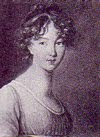
The 18th century child's gray/burgundy marled stockings (upper left), on 3.25mm bronze needles, are made of unlabeled wool of uncertain date from my thirty year old stash at a gauge/tension of 6 1/2 stitches/inch. The undyed ones below, on 3.25mm birch needles, are made of hand spun from the wool of a local flock of a Dorset-Wiltshire historic breed with a gauge/tension of 7 stitches/inch. The patterns for both are loosely based on stockings I have seen in photographs from books and various museum's and other institutions' collections. Both stockings have the traditional garter stitch rows at the tops, and the undyed pair has a series of openings worked with a Yarn Over/Knit 2 Together combination, so as to create an area where a garter or ribbon can be threaded through the top of the stocking.
The 19th century adult dark brown stockings are on 2.00mm metal needles knit in old, thin Dritz *sports yarn* (wool) that I would love to be able to precisely date. The ribbing (more commonly found in the 19th century) at the top is a *K3, P1* combination with 15 stitches/inch. Still in the design process, they will probably be partially based on a pair in the collection of Old Sturbridge Village (http://www.osv.org/collections/collection_viewer.php?N=26.17.92a-b).









